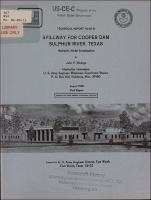Please use this identifier to cite or link to this item:
https://hdl.handle.net/11681/13613Full metadata record
| DC Field | Value | Language |
|---|---|---|
| dc.contributor | United States. Army. Corps of Engineers. Fort Worth District | - |
| dc.contributor.author | George, John F. | - |
| dc.date.accessioned | 2016-08-18T19:14:38Z | - |
| dc.date.available | 2016-08-18T19:14:38Z | - |
| dc.date.issued | 1980-08 | - |
| dc.identifier.uri | http://hdl.handle.net/11681/13613 | - |
| dc.description | Technical Report | - |
| dc.description | Abstract: Tests were conducted on a 1:36-scale model of Cooper Lake Spillway to investigate the hydraulic performance of the structure for various flow conditions. The model reproduced approximately a 1,300- ft- long approach area, the entire service spillway including nonoverflow sections, and 800 ft of exit channel. Approach conditions immediately upstream of the spillway created a buildup of the water surface along the left and right sides of the spillway. Modifications to the approach wing walls eliminated the buildup of the water surface, but did not significantly improve the velocity distribution or flow conditions throughout the structure. The modified wing walls were considerably more expensive to construct; therefore, the original wing wall design was reinstalled. Satisfactory flow conditions were observed on the trajectory and in the stilling basin with all tainter gates opened 3 ft and greater. However, unsatisfactory flow conditions occurred in the stilling basin when using equal tainter gate openings of 2 ft and less or sluice gates to regulate low discharges. The depth of tailwater did not allow the low discharges to spread properly across the lower parabolic trajectory, which resulted in unstable flow conditions in the stilling basin. Modifications consisting of chute blocks and deflectors positioned on the trajectory and sluice outlets, respectively, were ineffective in improving flow conditions in the stilling basin. Optimum combinations of sluice gate operations for regulating various discharges were determined with normal pool elevation (440) and different tailwater elevations. The same optimum arrangements were determined for tainter gate operations. Riprap requirements were determined for the area immediately downstream from the stilling basin and for the outlet channel. | - |
| dc.publisher | Hydraulics Laboratory (U.S.) | - |
| dc.publisher | Engineer Research and Development Center (U.S.) | - |
| dc.relation | http://acwc.sdp.sirsi.net/client/en_US/search/asset/1033503 | - |
| dc.relation.ispartofseries | Technical report (U.S. Army Engineer Waterways Experiment Station) ; HL-80-15. | - |
| dc.rights | Approved for public release; distribution is unlimited. | - |
| dc.source | This Digital Resource was created from scans of the Print Resource | - |
| dc.subject | Cooper Dam | - |
| dc.subject | Flow characteristics | - |
| dc.subject | Hydraulic models | - |
| dc.subject | Spillways | - |
| dc.subject | Sulphur River | - |
| dc.subject | Texas | - |
| dc.subject | Hydraulic structures | - |
| dc.title | Spillway for Cooper Dam, Sulphur River, Texas : hydraulic model investigation | - |
| dc.type | Report | en_US |
| Appears in Collections: | Technical Report | |
Files in This Item:
| File | Description | Size | Format | |
|---|---|---|---|---|
| TR-HL-80-15.pdf | 6.61 MB | Adobe PDF |  View/Open |